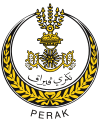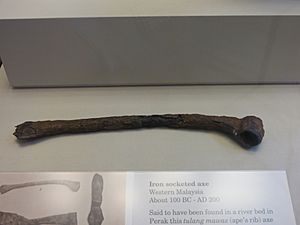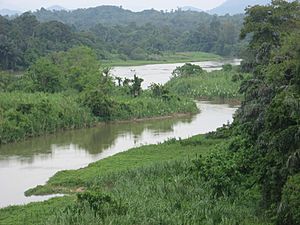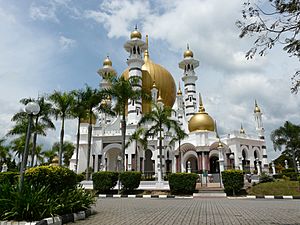Perak facts for kids
Quick facts for kids
Perak
Negeghi Peghak
|
|||
|---|---|---|---|
| Perak Darul Ridzuan ڤيراق دار الرضوان |
|||
| Other transcription(s) | |||
| • Jawi | ڤيراق | ||
| • Chinese | 霹雳 | ||
| • Tamil | பேராக் | ||
|
|||
| Motto(s):
Perak Aman Jaya
|
|||
| Anthem: Allah Lanjutkan Usia Sultan | |||
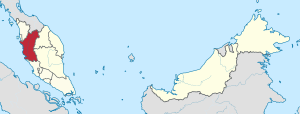
|
|||
| Capital | Ipoh | ||
| Royal capital | Kuala Kangsar | ||
| Government | |||
| • Type | Parliamentary constitutional monarchy | ||
| Area | |||
| • Total | 21,035 km2 (8,122 sq mi) | ||
| Population
(2016)
|
|||
| • Total | 2.48 million | ||
| Demonym(s) | Perakian, Perakese, Peraknese | ||
| Human Development Index | |||
| • HDI (2010) | 0.784 (high) (7th) | ||
| Postal code |
30xxx to 36xxx
39xxx |
||
| Calling code | +605 | ||
| ISO 3166 code | MY-08 | ||
| Vehicle registration | A | ||
| Pangkor Treaty | 1874 | ||
| Federated into FMS | 1895 | ||
| Japanese occupation | 1942 | ||
| Accession into the Federation of Malaya | 1948 | ||
| Independence as part of the Federation of Malaya | 31 August 1957 | ||
Perak is a state in Malaysia. Its full name is Perak Darul Ridzuan, which means "Abode of Grace". It is one of Malaysia's thirteen states and the fourth largest. Perak shares borders with several other states. These include Kedah and Penang to the north and northwest. It also borders Kelantan and Pahang to the east. To the south, it meets Selangor. The Strait of Malacca is to its west.
Ipoh is the administrative capital of Perak. It was once famous for its tin mining. However, when tin prices dropped, it affected the state's economy. The royal capital is Kuala Kangsar. This is where the palace of the Sultan of Perak is located.
Contents
What Does the Name Perak Mean?
The official name of the state is Perak Darul Ridzuan. The word Perak means "silver" in Malay. This name likely comes from the shiny, silver color of tin. In the 1890s, Perak had the world's richest tin deposits. It was a very important place for the British Empire.
Some people also say the name comes from the "glimmer of fish in the water". They sparkled like silver. Darul Ridzuan is an Arabic name for the state. It means "land of grace" or "abode of grace".
A Look at Perak's History
Long ago, there was a Hindu-Malay Kingdom called Gangga Negara in northwest Perak. Old discoveries show that people lived in Perak even in prehistoric times.
Modern Perak began after the Malacca Sultanate fell. Raja Muzaffar Shah, a prince from Malacca, escaped the Portuguese in 1511. He started his own kingdom along the Sungai Perak (Perak River) in 1528. Perak had a lot of tin. Because of this, outsiders often tried to take control of it.
Dutch Influence in Perak
The Dutch wanted to control the tin trade in the 1600s. They built forts near the Perak River and on Pulau Pangkor. The Dutch arrived in Perak in 1641. They wanted to control tin and spice trading.
However, the people of Perak did not like this. In 1651, they attacked and destroyed the Dutch trading post. The Dutch had to leave. They tried to make new agreements, but the people of Perak resisted.
In 1670, the Dutch returned to build a fort on Pangkor Island. Perak agreed because they feared an attack from Siam. But in 1685, Perak attacked the Dutch again. The Dutch were forced to leave and close their base.
British Rule in Perak
In the 1800s, many groups tried to invade Perak. These included the Bugis, Acehnese, and Siamese. The British stepped in around 1820. They stopped Siam from taking over Perak.
More and more Chinese immigrants came to work in the tin mines. These groups often fought for control. The Perak Sultanate struggled to keep order. In 1874, the British made a treaty called the Pangkor Treaty. This treaty made Sultan Abdullah the ruler of Perak. It also meant he had to accept a British Resident. This British official had a lot of power.
In 1875, some Perak chiefs killed the British Resident, James W. W. Birch. This led to a short war in 1876. Sultan Abdullah was sent away. A new British Resident, Sir Hugh Low, took over. He was good at understanding Malay language and customs. He also brought the first rubber trees to Malaya.
Perak joined other states to form the Federated Malay States in 1896. British rule continued until 1948. Perak became independent on August 31, 1957, as part of the Federation of Malaya.
How Perak is Governed
Constitutional Monarchy in Perak
Perak is a constitutional monarchy. This means it has a ruler, the Sultan, but his power is limited by a constitution. The current Sultan of Perak is Sultan Nazrin Muizzuddin Shah. He became the 35th Sultan of Perak on May 29, 2014.
Administrative Divisions
Perak is divided into 12 administrative districts. These districts are further split into smaller areas. Here are the 12 districts listed by their population:
| Rank | Districts | Seat | Population 2009 |
|---|---|---|---|
| 1 | Kinta | Batu Gajah | 846,300 |
| 2 | Larut, Matang and Selama | Taiping | 320,100 |
| 3 | Manjung | Seri Manjung | 247,200 |
| 4 | Hilir Perak | Teluk Intan | 232,800 |
| 5 | Kerian | Parit Buntar | 196,500 |
| 6 | Batang Padang | Tapah | 191,900 |
| 7 | Kuala Kangsar | Kuala Kangsar | 176,000 |
| 8 | Perak Tengah | Seri Iskandar | 116,500 |
| 9 | Hulu Perak | Gerik | 114,900 |
| 10 | Kampar | Kampar | 98,534 |
| 11 | Muallim | Tanjung Malim | 69,639 |
| 12 | Bagan Datuk | Bagan Datuk | 17,967 |
On November 26, 2015, a new district called Muallim was announced. It includes Tanjung Malim. Sultan Nazrin officially opened it on January 11, 2016.
Then, on January 9, 2017, Bagan Datuk became the 12th district. This area is a big producer of coconuts in Malaysia.
Who Lives in Perak?
Perak was once the most populated state in Malaysia. But after the tin mining industry declined, many people moved away. They went to states with more job opportunities. These include Penang, Selangor, and Kuala Lumpur.
| Ethnic Group | Population | |||
|---|---|---|---|---|
| 2001 | 2010 | |||
| Malay | 1,101,105 | 53.68% | 1,238,357 | 52.63% |
| Other Bumiputras | 63,809 | 2.71% | ||
| Bumiputra total | 1,302,166 | 55.35% | ||
| Chinese | 643,129 | 31.35% | 693,397 | 29.47% |
| Indian | 262,121 | 12.78% | 281,688 | 11.97% |
| Others | 6,536 | 0.32% | 6,039 | 0.26% |
| Malaysian total | 2,012,891 | 98,03% | 2,283,290 | 97.05% |
| Non-Malaysian | 38,345 | 1.87% | 69,453 | 2.95% |
| Total | 2,051,236 | 100.00% | 2,352,743 | 100.00% |
Perak's population grows slowly, about 0.4% each year. Here's how the population has grown over the years:
- 1980: 1,743,655
- 1990: 1,877,471
- 2000: 1,973,368
- 2010: 2,258,428
- 2015: 2,477,700
Religions in Perak
| Religion in Perak – 2010 Census | ||||
|---|---|---|---|---|
| religion | percent | |||
| Islam | 55.3% | |||
| Buddhism | 25.4% | |||
| Hinduism | 10.9% | |||
| Christianity | 4.3% | |||
| Chinese Ethnic Religion | 1.7% | |||
| No Religion | 0.9% | |||
| Others | 0.8% | |||
| Unknown / None | 0.7% | |||
In 2010, most people in Perak were Muslim (55.3%). Many were also Buddhist (25.4%) or Hindu (10.9%). Christians made up 4.3% of the population. Other religions included Chinese folk religions. A small number of people had no religion.
Most Chinese people in Perak are Buddhist (83.7%). Some are Christian (9.2%) or follow Chinese folk religions (5.8%). Most Indian people are Hindu (87.6%). Some are Christian (6.1%) or Muslim (2.67%). All Malays are Muslim, as defined by Malaysian law.
Perak's Geography and Climate
Perak covers an area of 21,035 square kilometers. This is about 6.4% of Malaysia's total land. It is the second-largest state in Peninsular Malaysia. It is the fourth-largest in all of Malaysia.
The longest river in Perak is the Perak River (Sungai Perak). It starts in the mountains near the Perak, Kelantan, and Thailand borders. It flows into the Strait of Malacca. It is the second-longest river in Peninsular Malaysia.
Perak's Climate
Perak has warm and sunny days all year. The nights are cool. It rains sometimes in the evenings. The temperature stays mostly between 23°C and 33°C. The air is often humid, over 82.3%. Perak gets about 3,218 mm of rain each year.
Fun Places to Visit in Perak
The Lost World of Tambun is a theme park. It is surrounded by a 400-million-year-old limestone mountain. The park also has a hotel with 175 rooms.
Kuala Kangsar is the royal town. It is about 48 km north of Ipoh. Three important buildings are there:
- Istana Iskandariah: This is the palace of the Sultan of Perak. It sits on a hill overlooking the river.
- Istana Kenangan: This building was a temporary palace. It is known for its unique architecture.
- Ubudiah Mosque: This is a stunning mosque. It has many bright golden domes.
The Perak State Museum is in Taiping. It is the oldest museum in Malaysia.
Kellie's Castle is in Batu Gajah. It was started in 1915 but never finished. The owner, William Kellie Smith, died. His wife sold the castle. People once believed it was haunted. It has secret rooms and a hidden tunnel. Today, it is a popular tourist spot.
The Gua Tempurung cave is between Gopeng and Kampar. Many locals and tourists visit it, especially during busy times.
Pangkor Island is reachable from Lumut. It has fishing villages and white beaches. The warm waters are great for swimming and diving. Resorts are available for visitors. Popular beach areas are Pasir Bogak and Teluk Nipah. Here you can scuba-dive, snorkel, wind-surf, and fish. Teluk Ketapang (Turtle Bay) is where turtles still come to lay their eggs.
For adventure, try white water rafting at My Gopeng Resort in Gopeng. You can also try waterfall abseiling and jungle trekking. Some visitors go trekking to see the rafflesia flower.
The Belum-Temengor Forest Reserve is a huge untouched forest. It has exotic animals like elephants, rhinoceroses, tapirs, and tigers. You can take guided tours there.
The Sungai Klah Hot Spring Park has hot springs and a therapeutic park. It is at the foot of the Titiwangsa Range. You can see oil palm and durian farms there. You can even boil eggs in the hot springs!
Bukit Larut (Maxwell Hill) was founded in 1844. It is the wettest place in Malaysia. It gets over 500 cm of rain each year. On clear days, you can see the coastline and the Straits of Malacca. You might even see Penang or Pangkor Island.
The Taiping Lake Gardens was built on an old tin mine. It opened in 1880. It was the first public garden in Malaya. It covers 64 hectares. It has ten lakes, a lotus pool, and bridges. There are tracks for jogging, a roller-skating rink, and paddleboat rides. It is full of tropical plants and wildlife.
Getting Around Perak
Railway Travel
The railway system is being updated. Electric trains now run on double tracks from Kuala Lumpur to Ipoh. The Ipoh railway station is in the city center. It has a Moorish style and is white. People call it the Taj Mahal of Ipoh. It was finished in 1935.
The Ipoh railway station is said to be the "second-most beautiful railway station in Malaysia." It is located on Jalan Panglima Bukit Gantang Wahab.
What to Eat in Perak
Lemang is a Malay treat. It is made from sticky rice cooked in a bamboo tube over a slow fire. People eat it during festivals like Hari Raya Aidilfitri and Hari Raya Haji. It is often eaten with rendang. Some say lemang came from local people who cooked rice in bamboo.
Tempoyak is another Malay delicacy. It is durian fruit that has been preserved. People usually eat it with chilies and other dishes. It is popular because durian is a favorite fruit among locals. Tambun pomelo is also a very popular fruit in Perak.
Rendang Tok is a famous Perak dish. It is beef cooked slowly in a large pan over a bonfire. It is usually served during Malay Muslim festivals or weddings in Perak.
Ipoh, the state capital, is known for its soup noodle dish called sar hor fun. It is also famous for Hainanese chicken rice.
-
Mangrove logs at Matang Charcoal Factory.
-
A bowl of Mee Udang (Prawn noodles).
-
Cave painting in Perak Tong Limestone Cave Temple.
Images for kids
-
Perak Malay girls in traditional dress, Kuala Kangsar, image pre-1921.
-
British female explorer, naturalist and writer Isabella Bird led by two local men on her first elephant ride in Perak, c. 1883.
-
Group portrait of 4th British Resident Hugh Low and two Perak and Larut Malay rajas, c. 1880–1881.
-
Japanese characters map of Malaya under the occupation of the Empire of Japan, c. 1942.
-
Sikh infantry of the Indian Army serving alongside British Empire troops during a fierce battle against the Imperial Japanese Army (IJA) in Kampar, c. 1941–1942.
-
Notorious MLNA leader Lee Meng in Ipoh District during the Malayan Emergency, c. 1951.
-
Sir Gerald Templer and his assistant, Major Lord Wynford, inspecting the Kinta Valley Home Guard (KVHG), Perak, c. 1952.
-
Perak, western Malay Peninsula (NASA satellite image).
-
Limestone hills of Tambun near the Enlighten Heart Tibetan Buddhist Temple.
-
Fishing village in Kuala Sepetang illuminated by lamps during the blue hour. Agriculture, especially freshwater fish and prawn farming, is a major economic sector in Perak, along with services and manufacturing.
-
Old and new infrastructure in capital city Ipoh.
-
A PerakTransit bus at Kuala Kangsar road, Ipoh.
-
Chinese architecture of Universiti Tunku Abdul Rahman (UTAR) Campus Grand Hall, Kampar, at night.
-
Malay language road sign with English location name in Ipoh.
-
Labu sayong pottery traditional in Kuala Kangsar.
-
Ipoh white coffee, Perak's signature drink.
-
Mount Korbu with surrounding vegetation.
-
Twilight in Lumut Beach.
See Also
 In Spanish: Perak para niños
In Spanish: Perak para niños



